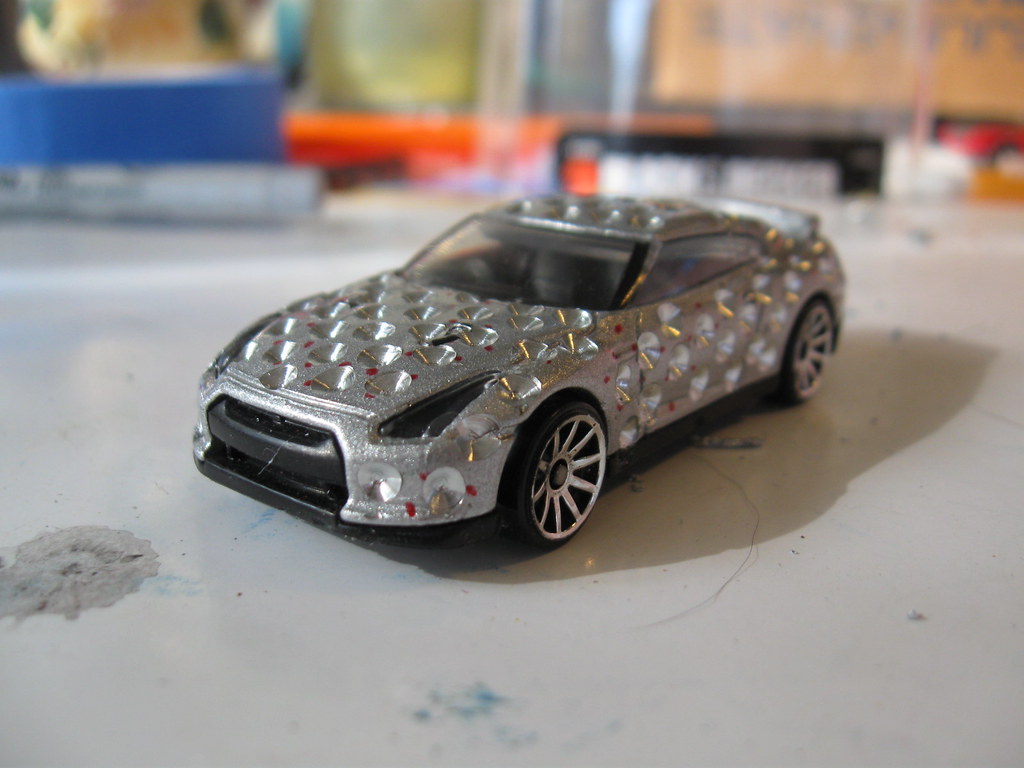Mythbusters golf ball car, Hot Wheels style
This post was originally posted in November 2009 on the Redline Derby blog
I’m a fan of Mythbusters. There’s nothing better (or worse) than a Mythbusters Marathon on a Sunday afternoon. In a recent episode they did an experiment that involved dimpling car like a golf ball to see if it got better gas mileage (Dirty Car vs. Clean Car). In an extreme case they discovered the theory was plausible…and that got me thinking, would dimples make a Hot Wheels car go faster?
See all the photos from the Mythbusters project
The theory
The whole concept behind the dimples was creating less drag on the car, making it more efficient. And in theory, the less drag a car has the faster it can go. It’s one thing when applied to a car with an engine, it’s another thing applied to a gravity car like a Hot Wheels car. Not to mention, you have the scale to worry about. Nonetheless, it sounded like a fun little experiment.
However, when I say “experiment” I need to disclose that this was quite possibly the most un-scientific experiment ever. I don’t have the tools or time to do a Mythbusters-quality job. But it was fun all the same and the results honestly surprised me.
The control
To start, I picked out two of the exact same car, the Nissan GT-R, and labeled them A and B. The Nissan looked like an average car that had a lot of metal surface to dimple.

To get a control (of sorts), I ran both cars unmodified down the track 10 times, alternating lanes each time to help eliminate any effects the track the may have on the car. The control races found that both cars were pretty well matched, as one would expect. However, Car B proved to lose two more races which meant it was the slower car and it would thus get the dimpling in an attempt to make it faster than the undimpled Car A.
I also weighed the cars before the races and dimpling, each car weighing 32 grams. For every race I used the official Redline Derby race track which is 18-feet long with a 4-foot drop.
Results of the control races: Car A, 6 wins; Car B, 4 wins
- Race 1, Car A
- Race 2, Car A
- Race 3, Car B
- Race 4, Car A
- Race 5, Car B
- Race 6, Car B
- Race 7, Car B
- Race 8, Car A
- Race 9, Car A
- Race 10, Car A
Grab the drill
Once the control was set, I went to work on dimpling Car B. I had good intentions to keep the dimples evenly spaced and as close to golf ball pattern as possible, I even dotted the car with a Sharpie to help guide my dimples. But as I started the dimpling process I quickly realized that with the tools I had – a Dremel and drill – that type of control was not going to be possible.

I used a 1/8? bit with a Dremel to make the dimples. I did my best to maintain a golf ball pattern and overall, I think it turned out pretty well. After 20 minutes of drilling, Car B had gained 126 dimples. Again, I must disclaim that this was all “by eye” drilling, so the dimples are not all the same size, depth, or distance from each other…but they’re close (this isn’t hard science, folks). I’m sure the dimples are also not the right scale compared for the car, they should be a lot smaller.
I weighed Car B after all the drilling was done to find I had shaved off one gram of weight, the car now being 31 grams. Like the Mythbusters, to keep things as close to fair as possible, I took some clay and added back the one gram of weight lost to the bottom of the car so once again both cars were 32 grams. Then it was time to race.
Dimpled vs. smooth
I ran 10 more races like I did before, alternating lanes between runs. Considering all the sloppy science going on here, I was honestly surprised by the results.

Results of dimple races: Car A, 2 wins; Car B, 8 wins
- Race 1, Car B
- Race 2, Car B
- Race 3, Car B
- Race 4, Car B
- Race 5, Car B
- Race 6, Car B
- Race 7, Car B
- Race 8, Car A
- Race 9, Car A
- Race 10, Car B
The unscientific results surprised me
I expected the results to be similar to the control races, both cars still being pretty much equal. I figured aerodynamics and drag at such a small scale wouldn’t make much impact. I don’t think I proved that it does, but I’m still surprised that the dimpled car won so many races. It was far more lopsided than I expected. It seemed the dimpled car was faster.

Do dimples make a Hot Wheels car go faster? Sure, why not? Based on this simple experiment, it looks like a dimpled car performs better than one that is not dimpled. Is it because of aerodynamics and drag? I guess so…that’s the theory, anyway. However, this little project was way too casual to say anything for sure. Since we didn’t use the exact same car for the pre-dimpling and post-dimpling, and the dimpling process wasn’t as accurate as it should have been…so there is lots of room for error. But it was fun to try all the same.
I’m gonna call it: plausible
I had two cars that were the same model out of the box, and after racing they were about even. After one car was dimpled, it won more races than the one that wasn’t dimpled. That’s all I know.
Discussion
One of the first "features" I did when Redline Derby started was a copy of an early Mythbusters myth that has since become a classic: golf ball car.
I hadn't thought of this feature in long, long time but today in my video feed popped up a clip from Adam Savage talking about the golf bar car and their experiment with it. Savage is one of my favorite people to watch and learn from but in this case it was just a funny walk down memory lane.
Video from Tested
www.youtube.com/watch?v=snNL5GgOq_c
This jaunt into the past was also a reminder of how RLD started and what my sort of intent was behind it - a place to share and talk about what you can do to make cars faster. It's become so much more since then but this is a look back at how it all started.
The post above is NOT the original thread. It was originally posted on and old RLD blog that has since been removed, so the original comments aren't here. But, I do remember in that thread that an honest scientist from Ohio State joined the conversation, which I thought was pretty cool.
Anyway, if you haven't seen this feature before, give it a quick read and maybe it can spark some creative ideas on what you can do that is maybe a little "out of the box" to make your cars faster.
Seeing that video the other day, I thought about trying it out. I'm glad to see that you already had. Thanks for sharing that!
That is a crazy episode and your results are even crazier. I love it.
I would coat the un-moddified car's chassis in identical fashion with clay and run the test again to see if underbody aero came into play or maybe weight distribution etc.
Fun stuff!!!
Matt
- Looking back, I'm sure the extra clay on the bottom made a big difference in that performance. But it was fun eitherway — redlinederby
Reminds me a lot of what the Swiss Cheese Invitational cars looked like.
Wow! I never saw the episode, but I was working on one right before I saw this! Cool!
Awesome experiment!
Cool experiment. I think the car looks very cool like that.


Cool...but weird.